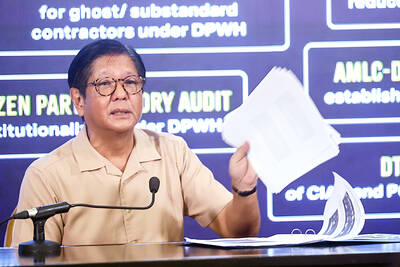The railroad is many things to people in Cambodia: playground, garbage dump, open-air toilet, livestock grazing ground, a dry path for traversing swampy terrain.
What it has not been for many years is working transportation for either people or freight. In fact, train service was halted completely last year.
That may change soon. Development specialists have persuaded the government to privatize the system, which officially reopened on Friday with one freight line between Phnom Penh and Touk Meas, near the Vietnamese border.
Eventually, they promise, a refurbished railroad will revive Cambodia’s economy and drag it out of decades of poverty and chaos.
It would be an important missing link in a proposed regional rail system that would stretch from Singapore to Kunming in China.
“It’s a powerful symbol of Cambodia’s reconstruction and redevelopment,” said Lachlan Pontifex, an aid expert with the Australian government, which is helping to fund the US$141.6 million effort.
While an efficient transport network holds out great promise for Cambodian businesses, the reclaiming of railroad land could sink thousands into deeper poverty. Many people who live and sell goods alongside the rails — often barely subsisting — fear they will be evicted from their homes. Others, like the operators of makeshift carts that ferry people along the tracks, known as “bamboo trains,” will lose a meager but reliable livelihood.
Cambodian and foreign backers said they are trying to minimize the disruptions, spending millions to compensate those affected.
French colonial rulers laid the first rails across the rice paddies and wetlands in the 1920s and by 1969, track stretched from the Thai border to the capital Phnom Penh and continued southwest to Sihanoukville on the Gulf of Thailand.
Then Cambodia plunged into chaos, beginning with a US-backed military coup and ending in the tyrannical Khmer Rouge regime. After the Khmer Rouge’s ouster in 1979, the southern line was still an occasional battleground. Stations crumbled, locomotives rusted and the system ground into dysfunction.
In the past dozen years, the country has seen a sputtering economic boom, which clogged the roads with people and goods.
However, the railway remained best avoided. A train ride between the capital and the provincial city Battambang, about 300km northwest, took more than a day, at a time when a taxi ride took less than four hours.
The Cambodian government awarded the Australian company Toll a 30-year joint venture contract to refurbish and operate the system, and shut it down completely in November last year. The largest chunk of financing for the project came in the form of a US$84 million loan from the Asian Development Bank (ADB) to the Cambodian government, with grants from Australia and others.
Earlier this month, after US$5 million in investments in new rails, signs, locomotive repairs and workforce training, the freight service to Touk Meas began operating ahead of Friday’s inauguration.
The entire railroad — including new spurs directly to the ports — is to be operational by 2013.
“Upgrading the infrastructure will improve competitiveness in Cambodia’s economy and promote direct investment in Cambodia itself,” said Putu Kamayana, director of the ADB’s Cambodian office.
For now, only freight will travel the rails, and the main beneficiary in the short run is likely to be Touk Meas’ cement industry. Officials said competition is already pushing down shipping costs, and should decrease costs for goods like fuel oil or rice.
Of greater concern to the thousands of Cambodians living on or near the railway line, however, is what will happen to them. On Phnom Penh’s outskirts, scores of families live in tin-roof shacks sometimes just an arm’s length from passing trains.
As many as 3,650 families could lose either their homes or their livelihoods. The ADB said more than US$3.5 million has been budgeted to compensate people who will be moved.
That’s small consolation to villagers like Khun Sarom, 38, who with his family of five runs a shop out of a bamboo-floored house just a few meters from the tracks in Phum Kseng, a village about 80km south of Phnom Penh. He said he’s lived in his house for 20 years, earning about US$5 a day selling cigarettes and pirated DVDs, but has no title to the land. He said he knew very little about the rail project and had no idea whether he would get any money or land if he was evicted.
“I guess it’s good, as long as I’m not kicked out,” he said.
North of Phnom Penh, Prak Pheam, 31, said he earns US$25 in a good week, and had hoped he would get some money for losing that income. However, he said only a handful of bamboo drivers have been told they would receive anything, and no one really understood how the money was being handed out.
“It’s unfair that I’m not getting money,” he said. “I’ll have to go back to the rice fields or get a job on a train.”

Philippine President Ferdinand Marcos Jr yesterday vowed that those behind bogus flood control projects would be arrested before Christmas, days after deadly back-to-back typhoons left swathes of the country underwater. Scores of construction firm owners, government officials and lawmakers — including Marcos’ cousin congressman — have been accused of pocketing funds for substandard or so-called “ghost” infrastructure projects. The Philippine Department of Finance has estimated the nation’s economy lost up to 118.5 billion pesos (US$2 billion) since 2023 due to corruption in flood control projects. Criminal cases against most of the people implicated are nearly complete, Marcos told reporters. “We don’t file cases for

A feud has broken out between the top leaders of the far-right Alternative for Germany (AfD) party on whether to maintain close ties with Russia. The AfD leader Alice Weidel this week slammed planned visits to Russia by some party lawmakers, while coleader Tino Chrupalla voiced a defense of Russian President Vladimir Putin. The unusual split comes at a time when mainstream politicians have accused the anti-immigration AfD of acting as stooges for the Kremlin and even spying for Russia. The row has also erupted in a year in which the AfD is flying high, often polling above the record 20 percent it

Ecuadorans are today to vote on whether to allow the return of foreign military bases and the drafting of a new constitution that could give the country’s president more power. Voters are to decide on the presence of foreign military bases, which have been banned on Ecuadoran soil since 2008. A “yes” vote would likely bring the return of the US military to the Manta air base on the Pacific coast — once a hub for US anti-drug operations. Other questions concern ending public funding for political parties, reducing the number of lawmakers and creating an elected body that would

‘ATTACK ON CIVILIZATION’: The culture ministry released drawings of six missing statues representing the Roman goddess of Venus, the tallest of which was 40cm Investigators believe that the theft of several ancient statues dating back to the Roman era from Syria’s national museum was likely the work of an individual, not an organized gang, officials said on Wednesday. The National Museum of Damascus was closed after the heist was discovered early on Monday. The museum had reopened in January as the country recovers from a 14-year civil war and the fall of the 54-year al-Assad dynasty last year. On Wednesday, a security vehicle was parked outside the main gate of the museum in central Damascus while security guards stood nearby. People were not allowed in because